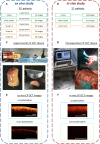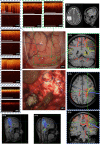Cross-Polarization Optical Coherence Tomography for Brain Tumor Imaging
- PMID: 31001471
- PMCID: PMC6455095
- DOI: 10.3389/fonc.2019.00201
Cross-Polarization Optical Coherence Tomography for Brain Tumor Imaging
Abstract
This paper considers valuable visual assessment criteria for distinguishing between tumorous and non-tumorous tissues, intraoperatively, using cross-polarization OCT (CP OCT)-OCT with a functional extension, that enables detection of the polarization properties of the tissues in addition to their conventional light scattering. Materials and Methods: The study was performed on 176 ex vivo human specimens obtained from 30 glioma patients. To measure the degree to which the typical parameters of CP OCT images can be matched to the actual histology, 100 images of tumors and white matter were selected for visual analysis to be undertaken by three "single-blinded" investigators. An evaluation of the inter-rater reliability between the investigators was performed. Application of the identified visual CP OCT criteria for intraoperative use was performed during brain tumor resection in 17 patients. Results: The CP OCT image parameters that can typically be used for visual assessment were separated: (1) signal intensity; (2) homogeneity of intensity; (3) attenuation rate; (4) uniformity of attenuation. The degree of match between the CP OCT images and the histology of the specimens was significant for the parameters "signal intensity" in both polarizations, and "homogeneity of intensity" as well as the "uniformity of attenuation" in co-polarization. A test based on the identified criteria showed a diagnostic accuracy of 87-88%. Intraoperative in vivo CP OCT images of white matter and tumors have similar signals to ex vivo ones, whereas the cortex in vivo is characterized by indicative vertical striations arising from the "shadows" of the blood vessels; these are not seen in ex vivo images or in the case of tumor invasion. Conclusion: Visual assessment of CP OCT images enables tumorous and non-tumorous tissues to be distinguished. The most powerful aspect of CP OCT images that can be used as a criterion for differentiation between tumorous tissue and white matter is the signal intensity. In distinguishing white matter from tumors the diagnostic accuracy using the identified visual CP OCT criteria was 87-88%. As the CP OCT data is easily associated with intraoperative neurophysiological and neuronavigation findings this can provide valuable complementary information for the neurosurgeon tumor resection.
Keywords: cross-polarization optical coherence tomography (CP OCT); glioblastoma; imaging assessment; intraoperative imaging; malignant brain tumors.
Figures






References
-
- Sun C, Lee KKC, Vuong B, Cusimano M, Brukson A, Mariampillai A, et al. , editors. Neurosurgical hand-held optical coherence tomography (OCT) forward-viewing probe. In: Proceedings Volume 8207, Photonic Therapeutics and Diagnostics VIII. San Francisco: SPIE BiOS (2012).
LinkOut - more resources
Full Text Sources
Research Materials
Miscellaneous

